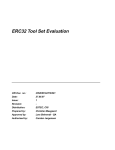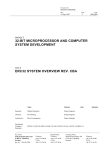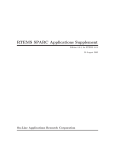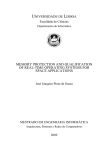Download The ERC32 GNU Cross-Compiler System
Transcript
The ERC32 GNU Cross-Compiler System Version 2.0 February 1999 Jiri Gaisler European Space Research and Technology Centre (ESA/ESTEC) 2 ERC32 GNU Cross-Compiler system European Space Agency [email protected] The ERC32 GNU cross-compiler system Copyright 1998 European Space Agency. Permission is granted to make and distribute verbatim copies of this manual provided the copyright notice and this permission notice are preserved on all copies. Permission is granted to copy and distribute modified versions of this manual under the conditions for verbatim copying, provided also that the entire resulting derived work is distributed under the terms of a permission notice identical to this one. Permission is granted to copy and distribute translations of this manual into another language, under the above conditions for modified versions. Introduction 3 1 Introduction 1.1 General This document describes the ERC32 GNU cross-compiler system version 2.0. Discussions are provided for the following topics: • contents and directory structure of ERC32CCS • compiling and linking ERC32 applications • usage of SIS and MKPROM • debugging ERC32 application with GDB/SIS The ERC32 GNU cross-compiler system is a multi-platform development system based on the GNU family of freely available tools with additional ‘point’ tools developed by Cygnus, OAR and ESTEC. The ERC32CCS consists of the following packages: • EGCS/GCC C/C++ compiler • GNAT Ada95 compiler • GNU binary utilities • RTEMS C/C++ real-time kernel • Newlib standalone C-library • SIS ERC32 simulator • GDB debugger with ERC32 remote debugging monitor (rdbmon) • DDD graphical front-end for GDB • MKPROM boot-prom builder 1.2 News in version 2.0 This version of ERC32CCS contains the following changes with respect to 1.3.2: • DDD version 3.1.3 • Mprom version 1.2.1 • Egcs-1.1.1 C/C++ compiler • Newlib-1.8.1 C library • RTEMS 4.0.0 official release with simplified compile procedure • Ada95 compiler based on gnat-3.11p and rtems-4.0.0 (full tasking and interrupt support) • GDB version 4.17 with gnat-3.11p support • SIS version 3.0.2 • Updated documentation 4 ERC32 GNU Cross-Compiler system 2 Installation and directory structure 2.1 Obtaining ERC32CCS ERC32CCS is only distributed via anonymous ftp. The primary home of ERC32CCS is the ESTEC ftp-server at ftp://ftp.estec.esa.nl/pub/ws/wsd/erc32/erc32ccs. Two platforms are supported: SPARC Solaris-2.5.1 (or higher), and x86 linux (libc5). Sources for rtems, rdbmon and mkprom are provided with ERC32CCS, the remaining sources can be found at the usual GNU sites or at the OAR home page. 2.2 Installation 2.2.1 Linux host The ERC32CCS directory tree is compiled to reside in /usr/local/erc32 on Linux platforms. After obtaining the gzipped tarfile with the binary distribution, un-compress and un-tar it in a suitable location - if this is not /usr/ local/erc32 then a link have to be created to point to the location of the ERC32CCS directory. The distribution can be installed with the following command: cd /usr/local gunzip -c erc32ccs-2.0-linux-tar.gz | tar xf After the compiler is installed, add /usr/local/erc32/bin to your search path. Note: ERC32CCS is compiled on slakware linux using libc5 libraries. RedHat linux and some versions of Debian might contain outdated libc5 libraries which causes the compiler to fail. In this case obtain file redhat-libc5.tar.gz which contains updated libc5 libraries. To install them on a Redhat system, do as follows: cd /usr/i486-linux-libc5/lib tar xzvf redhat-libc5.tar.gz /sbin/ldconfig -v 2.2.2 Solaris host The ERC32CCS directory tree is compiled to reside in /opt/gnu/erc32 on Solaris platforms. After obtaining the gzipped tarfile with the binary distribution, un-compress and un-tar it in a suitable location - if this is not /usr/local/erc32 then a link have to be created to point to the location of the ERC32CCS directory. The distribution can be installed with the following command: cd /opt/gnu gunzip -c erc32ccs-2.0-solaris-tar.gz | tar xf After the compiler is installed, add /opt/gnu/erc32/bin to your search path. 2.2.3 Contents of erc32 The created erc32 directory with the following sub-directories: bin doc include lib man rtems rtemsnp executables documentation host includes host libraries man pages rtems libraries rtems libraries (no posix) Installation and directory structure sparc-rtems src 5 target libraries (ERC32) various sources 2.3 Support Additional information and commercial technical support for the various tools is available as follows: gcc, gdb, newlib Cygnus Support http://www.cygnus.com/ rtems, gcc, newlib OAR http://www.oarcorp.com/ sis, rdbmon,mkprom J.Gaisler (ESTEC) [email protected] ddd - http://www.cs.tu-bs.de/softech/ddd/ gnat ACT http://www.act-europe.fr/ 6 ERC32 GNU Cross-Compiler system 3 Using ERC32CCS 3.1 ERC32CCS tools The following tools are included in ERC32CCS: ddd fcheck mkprom protoize sis sis64 sparc-rtems-ar sparc-rtems-as sparc-rtems-c++ sparc-rtems-c++filt sparc-rtems-g++ sparc-rtems-gasp sparc-rtems-gcc sparc-rtems-gdb sparc-rtems-gdb64 sparc-rtems-gnatcmd sparc-rtems-gnatmake sparc-rtems-gnatbind sparc-rtems-gnatf sparc-rtems-gnatprep sparc-rtems-gnatbl sparc-rtems-gnatkr sparc-rtems-gnatpsta sparc-rtems-gnatchop sparc-rtems-gnatlink sparc-rtems-gnatpsys sparc-rtems-gnatchp sparc-rtems-gnatls sparc-rtems-ld sparc-rtems-nm sparc-rtems-objcopy sparc-rtems-objdump sparc-rtems-ranlib sparc-rtems-size sparc-rtems-strings sparc-rtems-strip unprotoize graphic X11 front-end to GDB utility to check for FPU rev.B bugs boot-prom builder GNU protoize utility ERC32 simulator ERC32 simulator (with 64-bit time) library archiver cross-assembler (with some FPU rev.B fixes) C++ cross-compiler utility to demangle C++ symbols same as sparc-rtems-c++ assembler pre-processor C/C++ cross-compiler debugger with ERC32 simulator and remote target interface debugger with ERC32 simulator (64-bit time) Utility to print all GNAT command switches Ada make utility Ada binder Ada syntax checker and cross-reference generator Ada pre-processor Ada bind and link Ada file name kruncher Utility to print the Standard package Ada source code splitter Ada linker Utility to display the System package Ada source code splitter Ada library lister GNU linker utility to print symbol table utility to convert between binary formats utility to dump various parts of executables library sorter utility to display segment sizes utility to dump strings from executables utility to remove symbol table GNU unprotoize utility Using ERC32CCS 7 3.2 Documentation An extensive set of documentation for all tools can be found in doc and man. The following documents are provided: aarm.pdf as.bdf bfd.pdf binutils.pdf cpp.pdf ddd.pdf gcc.pdf gdb.pdf gnat_rm.pdf gnat_ug.pdf ld.pdf mkprom.pdf rtems_dev.pdf rtems_relnotes.pdf rtems_sparc.pdf rtems_user.pdf sis.pdf sparcv7.pdf Annotated Ada 95 Reference Manual Using as - the GNU assembler Libbfd - the binary file description The GNU binary utilities The C Preprocessor DDD - The Data Display Debugger Using and porting GCC Debugging with GDB GNAT reference manual GNAT User’s guide Using ld - the GNU linker Mprom manual page RTEMS Development environment guide RTEMS Release notes RTEMS SPARC Applications supplement RTEMS C User’s manual (this is the one you want!) SIS - SPARC instruction set simulator manual SPARC V7 Instruction set manual Data sheets for the ERC32 chip-set are also provided: mecspec.pdf tsc961e.pdf tsc962e.pdf sysover.pdf MEC rev.A Device specification TSC961 Integer Unit User’s manual TSC962 Floating-point Unit user’s manual ERC32 System overview erc32cba.pdf erc32cca.pdf ERC32 revision CBA bug list ERC32 revision CCA bug list The documents are all provided in PDF format, with searchable indexes. The GNU documents have embedded hyper-links and searchable document text. A free PDF viewer (‘acrobat’) can be downloaded from Adobe (http://www.adobe.com/). 8 ERC32 GNU Cross-Compiler system 3.3 Development flow The compilation and debugging of an ERC32-based applications is done in the following steps: 1. Compile and link program with gcc 2. Debug program in standalone simulator (SIS) or with gdb 3. Debug program on remote target with gdb 4. Create boot-prom for a standalone application The ERC32CCS-2.0 supports three types of applications; ordinary sequential C/C++ programs, multi-tasking real-time C/C++ programs based on the RTEMS kernel, and Ada-95 programs. Compiling and linking is done in much the same manner as with the host-based gcc and GNAT. 3.4 RTEMS applications As of ERC32CCS-2.0, compiling and linking of RTEMS applications is again done by adding the rtems compiler switch to gcc. This will instruct gcc compiler driver to add RTEMS specific include paths and libraries. To compile and link a RTEMS application, use ‘sparc-rtems-gcc’: sparc-rtems-gcc -g -rtems -O3 rtems-hello.c -o rtems-hello.exe The various compilation switches are explained in the gcc manual (gcc.pdf) and the man-pages. RTEMS is provided in two versions; with and without POSIX threads interface. If applications are written with the POSIX interface, add the -posix switch during compilation and linking: sparc-rtems-gcc -posix -g -O3 posix-app.c -o posix-app.exe The default load address is start of RAM, i.e. 0x2000000. Any load address can be specified through the -Ttext option (see gcc manual). Extensive documentation is provided on RTEMS in doc/rtems_user.pdf. 3.5 Compiling sequential C-programs Ordinary sequential C programs can be compiled without any particular switches to the compiler driver: sparc-rtems-gcc -g -O2 hello.c -o hello.exe 3.6 Compiling Ada95 programs Compiling and linking an Ada95 program is easiest done through gnatmake: sparc-rtems-gnatmake -g -O3 -gnatp dais.adb -largs -qgnat -rtems -bargs -r Note that the binder and linker arguments have to be provided to enable the correct libraries. Individual units can be compiled through gcc: sparc-rtems-gcc -c -g -O3 -gnatp dais.adb Binding and linking can also be done separately: sparc-rtems-gnatbind -r dais.ali sparc-rtems-gnatlink -qgnat -rtems -g -O3 dais.ali Using ERC32CCS 9 For details on how to use gnat, see the GNAT User’s Manual (gnat_us.pdf) and GNAT Reference Manual (gnat_rm.pdf). ERC32 interrupts can be attached using the Ada95 interrupt_attach method. The ERC32 interrupts (numbered 1 - 15), are mapped on Ada interrupt 17 - 31. Avoid ERC32 interrupt 13 which is used for the real-time clock. See the irqtest program in the examples directory on how to attach interrupts. The compiler is configured for a maximum of 20 tasks and 30 mutexes. If you need a different configuration, go to the erc32/src/libio directory, edit gnatinit.c and do a ’make install’. Alternatively, linking with a local gnatinit.c file is also possible. In this case the global file will not be used. NOTE: the Ada compiler is only provided for testing purposes, and is not by any means validated or guaranteed. A commercial, validated version is available from Ada Core Technology (http://www.acteurope.fr/). 3.7 Making boot-proms Both sequential C-programs and RTEMS applications are linked to run from beginning of ram at address 0x2000000. To make a boot-prom that will run on a standalone target, use the mkprom utility. This will create a compressed boot image that will load the application to the beginning of ram, initiate various MEC register, and finally start the application. mkprom will set all target dependent parameters, such as memory sizes, number of memory banks, waitstates, baudrate, and system clock. The applications do not set these parameters themselves, and thus do not need to relinked for different board architectures. The example below creates a boot-prom for a system with 1 Mbyte RAM, one waitstate during write, 3 waitstates for rom access, and 12 MHz system clock. For more details see the mkprom manual mkprom -ramsz 1024 -ramws 1 -romws 3 hello.exe -freq 12 hello.srec 3.8 Simple examples Following example compiles the famous ‘hello world’ program and creates a boot-prom in SRECORD format: > > > sparc-rtems-gcc -nortems -g -O2 hello.c -o hello mkprom hello -o hello.exe sparc-rtems-objcopy --adjust-vma=0x2000000 -O srec hello.exe hello.srec An Ada application compiled through gnatmake: > sparc-rtems-gnatmake -g -O3 -gnatp dais.adb -bargs -r -largs -qgnat -rtems sparc-rtems-gcc -c -g -O3 -gnatp dais.adb sparc-rtems-gnatbind -aO./ -I- -r -x dais.ali sparc-rtems-gnatlink -g -rtems -qgnat dais.ali >sparc-rtems-size dais text data bss dec hex filename 204720 6392 32268 243380 3b6b4 dais Several example C, C++ and Ada program can be found in src/examples. The RTEMS validation tests can be found in src/examples/RTEMS. 10 ERC32 GNU Cross-Compiler system 3.9 FPU rev.B bugs The FPU rev.B have a bug that will make certain lddf/stdf sequences fail. The compiler only rarely emits these sequences. The occurrence of such sequence can be check with the provided fcheck program. A modified assembler is also provided which will automatically insert NOPs in the failing sequences to correct this problem. The modified assembler also emits NOPs between ldf/fpop sequences with dependencies to circumvent a second FPU bug which is only occur if waitstates are used. Execution and debugging 11 4 Execution and debugging The applications built by ERC32CCS can be executed in four different ways; on the standalone simulator, on gdb with integrated simulator, on a remote target connected to gdb and on a standalone target board from prom. 4.1 Standalone simulator The standalone simulator can run both application produced by the compiler and srecord images produced by MkProm. The following example shows how the ‘hello world’ program is run: tellus > sis hello SIS - SPARC instruction simulator 2.7.6, Bug-reports to [email protected] copyright Jiri Gaisler 1995-1998 loading hello: section .text at 0x02000000 (26032 bytes) section .data at 0x020065b0 (1304 bytes) section .bss at 0x02006ac8 (40 bytes)(not loaded) serial port A on stdin/stdout sis> go Hello world IU in error mode (257) 2567 02000800 91d02000 ta 0 sis> Note that the program was started from address 0x2000000, the default start address. Programs always halt the IU after they have terminated, that is why the IU goes into error mode. The boot-prom image can also be simulated: tellus > sparc-rtems-sis hello.srec SIS - SPARC instruction simulator 2.7.6, Bug-reports to [email protected] loading hello.srec: section .sec1 at 0x00000000 (16784 bytes) serial port A on stdin/stdout sis> run ERC32 boot loader v1.0 initialising RAM decompressing .text decompressing .data starting hello Hello world! IU in error mode (257) sis> copyright Jiri Gaisler 1995-1998 12 ERC32 GNU Cross-Compiler system 4.2 GDB with simulator To do symbolic debugging of both C and Ada applications, use gdb. After gdb is started, the simulator has to attached and the program loaded. It is important that the applications have been compiled with the -g switch. Below is a sample session: tellus > sparc-rtems-gdb hello (gdb)tar sim SIS - SPARC instruction simulator 2.7.6 Bug-reports to Jiri Gaisler ESA/ESTEC ([email protected]) serial port A on stdin/stdout Connected to the simulator. (gdb) (gdb) load (gdb) break main Breakpoint 1 at 0x20014e4: file hello.c, line 4. (gdb) run Starting program: /home/jgais/erc32/src/examples/hello Breakpoint 1, main () at hello.c:4 4 printf(“Hello world!\n”); (gdb) cont Continuing. Hello world! Program exited normally. (gdb) 4.3 GDB with remote target To attach gdb to a remote targets similar to attaching to the simulator. The baud rate for the serial port has to be specified and the remote target monitor has to run on the target. Also, a tip window should be connected to UART A to see the application output. Below is a sample session with a remote target: tellus> xterm -e tip -38400 /dev/ttya & [234] tellus > sparc-rtems-gdb hello (gdb) set remotebaud 38400 (gdb) tar erc32 /dev/ttyb Remote debugging using /dev/ttyb 0x2000000 in trap_table () (gdb) lo Loading section .text, size 0x65e8 vma 0x2000000 Loading section .data, size 0x4d0 vma 0x20065e8 (gdb) bre main Breakpoint 1 at 0x20014e4: file hello.c, line 3. (gdb) run Starting program: /home/jgais/erc32/src/examples/hello main () at hello.c:4 Execution and debugging 13 3 printf(“Hello world!\n”); (gdb) cont Continuing. Program exited with code 03. (gdb) Note that the program has to be loaded each time before it is started with ‘run’. This is to initialise the data segment to the proper start values. It is possible to switch between several targets (real or simulated) in the same GDB session. Use the GDB command detach to disconnect from the present target before attaching a new one. 4.4 Using DDD DDD is a graphical front-end to gdb, and can be used regardless of target. To start DDD with the debugger use: ddd --debugger sparc-rtems-gdb --attach-window A small script, dddx, is provided to start DDD in this configuration. You might need the full path in front of DDD if you already have a version of ddd installed. To get the source code displayed in the ddd window, click on locate(). The required gdb commands to connect to a target can be entered in the command window. See the GDB and DDD manuals for how to set the default settings. If you have problems with getting DDD to run, run it with --check-configuration to probe for necessary libraries etc. DDD has many advanced features, see the manual in erc32/doc (ddd.pdf) or the on-line manual under the ‘Help’ menu. 4.5 Remote target monitor The directory src/rdbmon contains the remote monitor which needs to be running on the target board to allow remote target debugging with gdb. The monitor supports ‘break-in’ into a running program by pressing Ctrl-C in GDB or interrupt in DDD. The two timers are stopped during monitor operation to preserve the notion of time for the application. Note that the remote debugger monitor only works with programs compiled with ERC32CCS, and thus NOT with programs compiled with Aonix Ada, VxWorks or similar. Type make to build the monitor. Depending on desired baudrate type either ‘make m38k4’, ‘make m19k2’ or ‘make m9k6’. Program the resulting *.srec file to you boot-prom. The remote debugger will be attached via UART B, console is on UART A. The maximum baudrate depends on the system clock of the target, 38K4 has been successfully used with a zero-waitstate ERC32 system running at 10 MHz. The monitor installs it self into the top 32K of ram. It therefore needs to know how large the ram is. The default ram size for the monitor is 2 Mbyte, adjust the Makefile if your system has different size. Internals (sequential C-programs) 14 5 Internals (sequential C-programs) Below is some information you might need if you wish to modify the way sequential C-programs are built. 5.1 Memory allocation The resulting executables are in a.out format and has three segments; text, data and bss. The text segment is at address 0x2000000, followed immediately by the data and bss segments. The stack starts at top-of-ram and extends downwards. Standalone app Remote debugger app Top-of-Ram Stack RDB interface Stack Heap Heap Data Data Text Text 0x2000000 Figure 1: ERC32CCS applications memory map The link script ram.M in erc32/share/sparc-erc32-aout/lib contains the setting for the available memory. The default setting is 2Mbyte. The applications are not compiled for a specific ram size, the initialisation sequence in the boot-prom (or remote target monitor) will set the top of stack to the highest available memory. The area between the data segment and the stack is used for the heap. 5.2 Libraries A posix compatible C-library and math library is provided with ERC32CCS. However, no file or other I/O related functions will work, with the exception of I/O to stdin/stdout. Stdin/stdout are mapped on UART A, accessible via the usual stdio functions. UART B can be accessed via file handle 3 (input) or 4 (output). The following function call will write size character from buf to UART B: write(4,buf,size); At startup of a program, the MEC real-time counter is programmed to increment one per microsecond. The function clock() will return the value of the counter. The sources to the board-specific part of the C-library is provided in erc32/src/libio. A user can modify the I/O functions according to his needs and install them into the C-library location (erc32/sparc-rtems/lib).
























